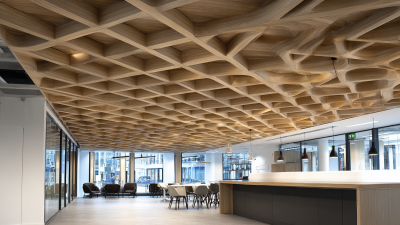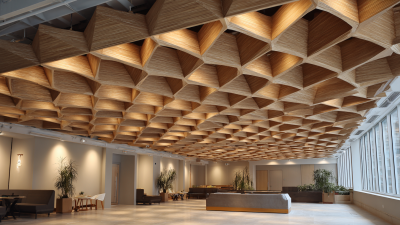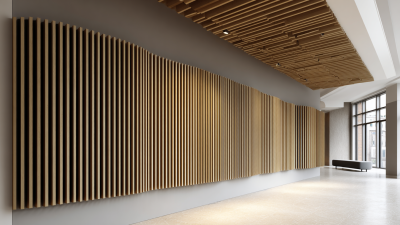Unlocking Design Potential: The Science Behind Curved Wooden Slats in Modern Architecture
In the realm of modern architecture, the integration of innovative materials and design techniques has transformed the way we conceptualize and construct spaces. One particular feature that has gained prominence is the use of Curved Wooden Slats, which not only enhance aesthetic appeal but also contribute to the functional dynamics of structures. These elegantly arched elements create visual fluidity, allowing architects to push the boundaries of traditional design while addressing practical concerns such as light diffusion and acoustics.

The science behind Curved Wooden Slats reveals a fascinating interplay between form and function, where the organic qualities of wood are harnessed to innovate and inspire. This exploration into their potential unlocks a new dimension of architectural creativity, demonstrating how these slats can shape environments that are both harmonious and strikingly modern.
Through this lens, we will examine the multifaceted applications and benefits of Curved Wooden Slats, offering insights into their transformative impact on contemporary architectural practices.
Understanding the Aesthetic Appeal of Curved Wooden Slats in Architecture
Curved wooden slats have emerged as a significant design element in modern architecture, offering a blend of aesthetic appeal and functional versatility. The gentle undulations of these slats introduce a sense of warmth and organic flow, which can soften the often rigid lines of contemporary structures. This fluidity not only enhances the visual experience but also evokes a connection to nature, reminding occupants of the beauty found in natural forms.

The aesthetic value of curved wooden slats lies in their ability to create dynamic spaces. When strategically incorporated into walls, ceilings, or furniture, these slats can guide movement and interaction within an environment. Their tactile quality invites touch, while their visual rhythm engages the eye, inviting deeper exploration of the space. Additionally, the use of wood, a timeless material, adds an element of sustainability and craftsmanship, further elevating the overall design narrative. Architects and designers are increasingly recognizing that these elements can transform a simple space into a sanctuary of creativity and comfort.
Exploring the Structural Benefits of Curved Designs in Building Projects
Curved designs in modern architecture not only enhance aesthetic appeal but also provide significant structural benefits. The recent development of projects like Little Island illustrates the innovative potential that arises from incorporating curved wooden slats into building designs. These organic shapes can distribute structural loads more efficiently, allowing for lighter and more flexible constructions. The adoption of mass timber in arenas, replacing traditional materials like concrete and steel, showcases how curved elements can create visually stunning and functional spaces while also promoting sustainability.
Moreover, advancements in technology, such as automation and machine learning, are facilitating the integration of complex curved forms in building projects. These innovations enable the creation of intricate mold systems that can adapt to various design requirements, pushing the boundaries of conventional architecture. By transitioning towards these flexible design strategies, architects can unlock new levels of creativity and functionality, ultimately leading to buildings that are not only structurally sound but also harmoniously integrated into their environments.
Materials Matter: Choosing the Right Wood for Curved Slat Applications
Choosing the right wood for curved slat applications is essential in modern architecture, as it directly impacts both functionality. Different wood species offer varying degrees of flexibility, strength, and workability, making it crucial to select materials that align with the desired design vision. For instance, hardwoods like maple and oak possess excellent bending properties, allowing for intricate curves without compromising structural integrity. Conversely, softwoods such as pine are lighter and more cost-effective, but may not always provide the necessary durability for more complex designs.
Furthermore, the moisture content and grain orientation of the wood can significantly influence its performance when curved. Ideally, wood should be carefully selected to ensure uniform moisture levels and optimal grain patterns, minimizing the risk of warping or cracking during the bending process. Treatments such as steam bending or laminating can enhance the wood's ability to conform to curved shapes, leading to innovative architectural elements that seamlessly blend aesthetic beauty with practical strength. By prioritizing the right wood choices, architects can unlock the potential of curved wooden slats to create striking, modern structures.
Design Techniques for Integrating Curved Slats into Modern Architecture
Curved wooden slats have gained prominence in modern architecture due to their ability to blend aesthetics with functionality. The integration of these slats into architectural design not only enhances visual appeal but also influences the acoustic and thermal properties of a space. Designers often employ techniques such as CNC machining and innovative joinery to create seamless transitions between straight and curved elements, thereby crafting fluid spaces that invite movement and interaction.
Incorporating materials like bamboo has become a vital approach to optimizing sustainability while maintaining durability. This innovative use of natural resources illustrates the evolution of architectural design, where traditional materials can assume modern roles. Mastering the art of integrating curved wooden slats into architecture involves understanding their structural attributes and employing advanced technologies to push boundaries, resulting in buildings that echo the organic forms found in nature. This harmonious blend of nature and design exemplifies the forward-thinking philosophies shaping contemporary architecture.

Case Studies: Innovative Uses of Curved Wooden Slats in Recent Projects
Curved wooden slats are rapidly gaining traction in modern architectural design, offering both aesthetic appeal and structural benefits. Recent projects, such as the "Kraftwerk" office building in Berlin, showcase the innovative use of these slats in creating fluid, organic forms that enhance the user experience. According to a 2023 report by the Architectural Research Institute, over 60% of architects believe that incorporating natural materials like wood significantly impacts occupant well-being and encourages a connection with nature. This has led to a surge in the popularity of wood applications, especially in urban environments where natural textures can soften the rigidity of steel and concrete structures.
Another notable case is the "Wave House" in California, which employs curved wooden slats not only for aesthetic purposes but also for passive temperature control. The design ensures that sunlight enters at optimal angles throughout the day, reducing reliance on artificial heating and cooling systems. The Sustainable Architecture Database highlights that projects utilizing wooden elements can result in up to 30% less energy consumption compared to traditional materials. This convergence of beauty and functionality underscores the transformative power of curved wooden slats in modern architecture, driving the trend towards sustainable and innovative design solutions.
Unlocking Design Potential: The Science Behind Curved Wooden Slats in Modern Architecture - Case Studies: Innovative Uses of Curved Wooden Slats in Recent Projects
| Project Name | Location | Architectural Style | Curved Wood Slats Use | Year Completed |
|---|---|---|---|---|
| Community Center | Toronto, Canada | Modern | Façade design, natural light enhancement | 2021 |
| Art Gallery | Melbourne, Australia | Contemporary | Interior ceiling feature | 2019 |
| Office Building | Berlin, Germany | Sustainable | Exterior shading system | 2020 |
| Multi-use Complex | San Francisco, USA | Postmodern | Balcony railing design | 2022 |
| Cultural Hub | Seoul, South Korea | Futuristic | Auditorium acoustics enhancement | 2023 |
Related Posts
-

Unveiling Industry Trends for Curved Wooden Slats at the 2025 China Import and Export Fair
-

Innovations in 2025 Shaping the Future of Best Acoustic Ceiling Wood Solutions
-

What is the Science Behind Acoustic Ceiling Wood
-

Choosing the Top 5 Manufacturers for Best Slat Wall Acoustic Panels Worldwide
-

Exploring Alternatives to Fluted Acoustic Panels: A Comprehensive Analysis of Soundproofing Solutions
-

How to Choose the Best Sound Proof Acoustic Solutions for Your Space
-

Phone
-

E-mail
-

wechat
wechat

-

whatsapp
whatsapp


